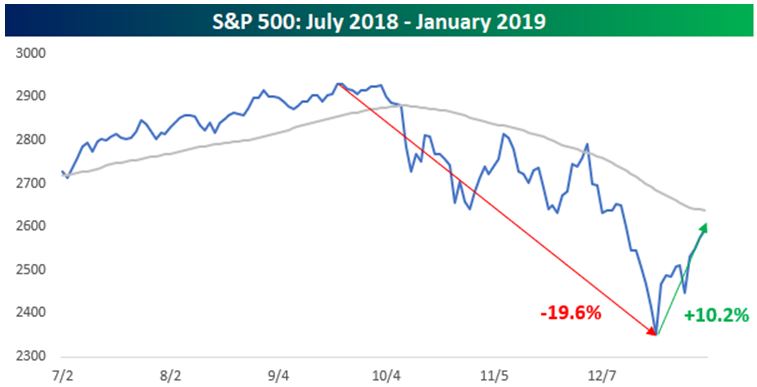What's a Mutual Fund?
You know that feeling when you're flying on an airplane and the plane hits an air pocket and the drop makes you feel like you're wearing your stomach as a hat? Well, you'd be forgiven if December's market volatility generated a similar sensation. And you'd be forgiven again if the recent upsurge caught you equally by surprise.
Through last week, the S&P 500 (our best barometer for US stocks) had surged over 10% after declining almost 20% during the recent correction. It's not normal for stocks to do this, but it's not unprecedented either. According to my research partners at Bespoke Investment Group, this kind of move has happened just 12 times since WWII. Historically, returns trend higher in the year following these sorts of gyrations but there's also a chance the market reaches what's called a "lower low" during that timeframe. If nothing else, this should accentuate the point that it's impossible to successfully "trade" market volatility.

Let's review two more finance terms from the YouGov poll we've looked at in recent weeks: Yield and Mutual Fund. Almost half of Americans polled report little knowledge of both terms. Please don't be one of them.
Yield – I've never been a farmer, but I still like to think about investing as being a little like farming. We plan, we plant, we tend, we harvest, we repeat. Over time the farmer's land yields bushels of corn, we earn dividends.
Our yield is typically a percentage representing the total dividends we're paid over the course of a year. If we own a mutual fund that holds stocks, for example, the fund pays us a dividend each quarter. Our payment is based on the number of shares we own, but it's simpler to think about it in percentage terms.
Assume a typical stock fund pays about 2% per year. If we buy $10,000 worth of the fund, we'd expect the fund to yield about $200 per year in dividends. This isn't our total return. That's another number incorporating our yield and appreciation over time.
What to do with our dividends...? Going back to the farming example, we could decide to harvest this yield and spend it, or we could replant to grow more corn for the next season. We refer to this as reinvesting our dividends. Doing so really adds up over time, producing almost half of our long-term total return. Should a farmer plant just once and hope to be successful over many seasons? Probably not.
Mutual Fund – A mutual fund is simply a company whose sole purpose is investing other people's money. There are different types, but we'll focus on the typical kind offered by firms like Vanguard and Fidelity. Each mutual fund company is regulated by the government and offers shares that the public can purchase. Each share buys you a little piece of a portfolio of stocks, bonds, cash, gold, real estate, and so forth.
The mutual fund buys and sells the investments and gets to make all the investment decisions while you passively hold shares. This might not sound sexy but investing in this way simplifies your life and makes it cheaper to own lots of stocks and bonds, helping you stay diversified.
The mutual fund "passes through" income it receives to shareholders throughout the year. Stock funds do this quarterly and bonds funds pay monthly. These payments represent the yield we just discussed.
There are nearly 10,000 mutual funds available today worth about $18 trillion in total. Interestingly, you wouldn't want to buy most of the available mutual funds because they're too expensive and their performance is lackluster. Finding the good ones is difficult and, frankly, one of the reasons I have a job.
Mutual funds and their brethren, exchange traded funds, make up the bulk of what I own personally and what I recommend to clients. If you have any questions at all, please don't hesitate to ask.
Here's a link to a summary of the YouGov poll:
https://today.yougov.com/topics/finance/articles-reports/2018/02/27/americans-confident-financial-terms-mean
Have questions? Ask me. I can help.
- Created on .



